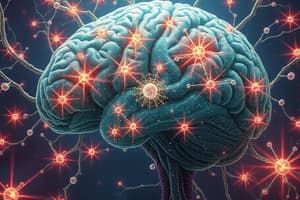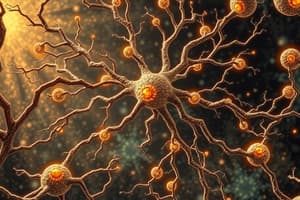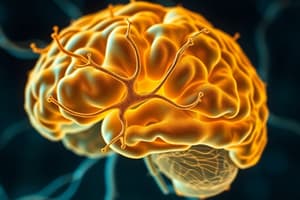Podcast
Questions and Answers
What was the primary improvement that Cajal made to Golgi's staining method?
What was the primary improvement that Cajal made to Golgi's staining method?
- He reduced the time required for staining.
- He developed a completely new staining technique.
- He used different chemical solutions.
- He allowed for complete visibility of nerve cells. (correct)
What theory did Cajal's observations contradict?
What theory did Cajal's observations contradict?
- Cell theory
- Reticular theory (correct)
- Synaptic theory
- Neuron doctrine
Who coined the term 'neuron' to refer to nerve cells?
Who coined the term 'neuron' to refer to nerve cells?
- Camillo Golgi
- Santiago Ramón y Cajal
- Wilhelm Waldeyer (correct)
- Albert Einstein
In what year did Cajal observe that the nervous system comprises billions of independent nerve cells?
In what year did Cajal observe that the nervous system comprises billions of independent nerve cells?
What key revelation about the structure of the nervous system came about by the end of the 19th century?
What key revelation about the structure of the nervous system came about by the end of the 19th century?
What was Golgi's stance regarding nerve cell connections?
What was Golgi's stance regarding nerve cell connections?
What was one of the major advancements in microscopy that supported the neuron doctrine in the 1950s?
What was one of the major advancements in microscopy that supported the neuron doctrine in the 1950s?
What was a significant technological advancement that Cajal utilized to enhance his research?
What was a significant technological advancement that Cajal utilized to enhance his research?
What did Cajal aim to show through his drawings of stained nerve cells?
What did Cajal aim to show through his drawings of stained nerve cells?
Which milestone marked a major turning point for Cajal in his research on the nervous system?
Which milestone marked a major turning point for Cajal in his research on the nervous system?
Cajal's artistic background contributed to his success in neuroscience primarily through which of the following?
Cajal's artistic background contributed to his success in neuroscience primarily through which of the following?
What is one notable fact about Cajal's legacy related to his documentation of observations?
What is one notable fact about Cajal's legacy related to his documentation of observations?
Which award did Santiago Ramón y Cajal receive in 1906?
Which award did Santiago Ramón y Cajal receive in 1906?
What characterized the condition of microscopy before the 1870s that impeded the examination of nervous tissue?
What characterized the condition of microscopy before the 1870s that impeded the examination of nervous tissue?
Cajal began his focused research on histology while studying to become what profession?
Cajal began his focused research on histology while studying to become what profession?
What role did Santiago Ramón y Cajal hold at the University of Barcelona in 1887?
What role did Santiago Ramón y Cajal hold at the University of Barcelona in 1887?
Flashcards
What was Cajal's key improvement to Golgi's staining method?
What was Cajal's key improvement to Golgi's staining method?
Cajal's modification of Golgi's staining method made the entire nerve cell visible, revealing its intricate structure.
What theory did Cajal's findings challenge?
What theory did Cajal's findings challenge?
Cajal's observations contradicted the Reticular theory, which proposed that the nervous system was a continuous network of interconnected fibers.
Who gave nerve cells their name?
Who gave nerve cells their name?
Wilhelm Waldeyer coined the term 'neuron' to refer to the individual nerve cells that make up the nervous system.
When did Cajal observe the independent nature of nerve cells?
When did Cajal observe the independent nature of nerve cells?
Signup and view all the flashcards
What major revelation about the nervous system came about by the end of the 19th Century?
What major revelation about the nervous system came about by the end of the 19th Century?
Signup and view all the flashcards
What was Golgi's view on nerve cell connections?
What was Golgi's view on nerve cell connections?
Signup and view all the flashcards
What microscopical advancement supported the neuron doctrine in the 1950s?
What microscopical advancement supported the neuron doctrine in the 1950s?
Signup and view all the flashcards
What technological improvement did Cajal utilize for his research?
What technological improvement did Cajal utilize for his research?
Signup and view all the flashcards
What did Cajal aim to achieve through his drawings?
What did Cajal aim to achieve through his drawings?
Signup and view all the flashcards
What marked a major turning point in Cajal's research?
What marked a major turning point in Cajal's research?
Signup and view all the flashcards
How did Cajal's artistic background contribute to his work?
How did Cajal's artistic background contribute to his work?
Signup and view all the flashcards
What's notable about Cajal's documentation of his work?
What's notable about Cajal's documentation of his work?
Signup and view all the flashcards
What prestigious award did Cajal receive in 1906?
What prestigious award did Cajal receive in 1906?
Signup and view all the flashcards
What was the state of microscopy before the 1870s that hindered the study of nervous tissue?
What was the state of microscopy before the 1870s that hindered the study of nervous tissue?
Signup and view all the flashcards
What profession was Cajal studying when he began his research on histology?
What profession was Cajal studying when he began his research on histology?
Signup and view all the flashcards
What was Cajal's role at the University of Barcelona in 1887?
What was Cajal's role at the University of Barcelona in 1887?
Signup and view all the flashcards
Study Notes
Santiago Ramón y Cajal
- Spanish neuroscientist and Nobel Prize winner known for his work on the nervous system
- Trained as a medical doctor, had a passion for drawing and art.
- Used microscopes to study the structure of the nervous system.
- Pioneered the use of Golgi's silver nitrate staining technique to visualize nerve cells.
- Modified Golgi's technique, enabling detailed observations of neuronal structures.
- Produced hundreds of illustrations of the human brain and nervous system.
- Proposed the "neuron doctrine" which states that individual, independent neurons communicate with each other through synapses, challenging the prevailing "reticular theory."
- His work laid the foundation for understanding the structure and function of the nervous system.
Neuron Doctrine
- Refuted the reticular theory, which claimed that nerve fibers were fused together in a continuous network.
- Instead, proposed that the nervous system is made up of billions of individual, independent neurons that communicate through electrical and chemical transmission across synapses.
- The neuron doctrine was accepted as the correct model for the structure and function of the nervous system in the 1950s after electron microscopy revealed the existence of synapses.
Camillo Golgi
- Italian doctor who invented a tissue-staining technique using silver nitrate to make nerve cells visible under a microscope.
- Golgi remained a staunch supporter of the reticular theory, despite the mounting evidence supporting the neuron doctrine.
Studying That Suits You
Use AI to generate personalized quizzes and flashcards to suit your learning preferences.





